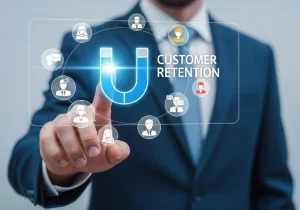What “Scaling Business” Really Means
Many teams confuse growth with scaling. Growth adds resources at the same rate as revenue. Scaling business grows revenue faster than costs by building leverage: smarter systems, better unit economics, and repeatable go‑to‑market motions.
In practice, scalable operations show up as:
- Unit economics that improve with volume (declining CAC, rising LTV).
- Process standardization that increases throughput without adding headcount.
- A stable growth engine that’s not overly dependent on one channel or whale client.
The Pillars of Sustainable Growth
To architect sustainable growth, focus on a handful of controllable pillars. Each one compounds over time.
- Product–Market Fit (PMF): The clearest indicator is retention and organic adoption, not just initial sales velocity.
- Process: Documented SOPs, automation, and quality assurance reduce error rates and costs.
- People: Roles, incentives, and leadership practices aligned to outcomes—think OKRs and clear ownership.
- Profitability: Healthy gross margins, CAC payback under 12 months for most B2B SaaS, and disciplined burn.
- Portfolio of channels: Multi‑channel acquisition with strong lifecycle marketing to maximize LTV.
Customer Outcomes First: The Bedrock of Scaling Business
Without durable customer value, scale is a mirage. Anchor on job-to-be-done outcomes. When your product reliably solves a burning problem, you unlock word‑of‑mouth, expansion revenue, and lower churn.
- Track activation milestones that correlate with long‑term retention.
- Measure time‑to‑value and reduce it with onboarding, templates, or guided setups.
- Run cohort analyses to see if newer customers retain better—an indicator of improving PMF.
According to research published by Harvard Business Review, even modest retention improvements can significantly increase profits due to compounding effects on LTV and customer referrals. See: HBR: The Value of Keeping the Right Customers.
Systems and Automation: The Engine of Sustainable Growth
Operational excellence is how you scale “effortlessly.” Every repeatable task deserves a playbook or a bot. The goal is fewer manual handoffs and more automated, observable processes.
- Sales: Lead scoring, automated follow‑ups, and proposal templates.
- Marketing: Lifecycle email, triggered in‑app nudges, and content syndication workflows.
- Success/Support: Knowledge bases, chatbots for level‑one issues, and proactive health scoring.
- Finance/RevOps: Billing automation, revenue recognition, and pipeline forecasting.
- Product/Engineering: CI/CD, feature flags, and observability to ship faster with less risk.
Document SOPs in a centralized repository. Measure turnaround times and defect rates. When you can see it, you can scale it.
Data-Driven Decisions: Metrics That Matter When Scaling
Sustainable growth comes from focusing on a concise, actionable dashboard—not dozens of vanity plots. Build a goal stack that ladder ups to revenue quality and retention.
- North Star Metric: A usage metric tightly tied to customer value (e.g., weekly active projects).
- Unit Economics: CAC, LTV, gross margin, and CAC payback period.
- Retention: Logo and revenue retention, churn reasons, and net revenue retention (NRR).
- Efficiency: Revenue per employee, sales cycle length, and pipeline coverage.
- Quality: NPS/CSAT, incident frequency, and first‑response times.
Use leading indicators (trial activation, qualified pipeline) to forecast outcomes. Pair this with weekly operating reviews that force decisions and accountability.
Team, Culture, and Leadership for Scaling Business
Scaling isn’t just a spreadsheet problem—it’s a leadership challenge. High‑performing organizations create clarity, speed, and ownership.
- Hiring for slope, not just intercept: Prioritize learners who thrive in evolving systems.
- Clear swimlanes: RACI charts and documented interfaces across functions reduce bottlenecks.
- Operating cadence: Quarterly OKRs, monthly business reviews, weekly standups.
- Psychological safety: Blameless postmortems and transparent scorecards accelerate iteration.
Companies like Atlassian and Shopify standardized rituals and documentation early, which helped them scale globally without sacrificing speed.
Profitable Growth Mechanics: Pricing, Packaging, and Monetization
To achieve sustainable growth, your pricing must match the value delivered and incentivize expansion. Don’t “set and forget.”
- Value metrics: Charge on a metric aligned to customer outcomes (seats, bandwidth, usage).
- Good‑better‑best packages: Create clear upgrade paths and avoid choice overload.
- Expansion revenue: Add‑ons, premium support, and advanced features drive NRR above 110% in B2B SaaS.
- Discount discipline: Tie discounts to multi‑year commitments or case studies, not desperation.
Review monetization quarterly with cohort‑level performance. Small pricing tweaks can produce outsized margin gains without new acquisition spend.
Go-to-Market Fit: Channel Strategy That Scales
The best scaling business strategies develop a repeatable go‑to‑market motion and then replicate it across segments or geographies.
- Product‑led growth (PLG): Frictionless trials, viral loops, and in‑product prompts for upgrades.
- Sales‑assisted: Layer BDRs and solution engineers to unlock higher ACVs once signals appear.
- Partner ecosystems: Integrations and channel partnerships extend reach and add credibility.
- Content and SEO: Evergreen assets that capture intent, supported by webinars and case studies.
Slack’s early PLG motion—free tier, easy invites, and integrations—reduced CAC and sped up adoption, illustrating how channel–product fit makes scale cheaper and faster.
Risk Management: How to Grow Without Breaking
Fast growth introduces fragility. Build guardrails to keep sustainable growth on track.
- Scenario planning: Model-based, upside, and downside; pre‑define cost levers and hiring gates.
- Operational resilience: Redundancies, cloud cost governance, and vendor diversification.
- Compliance and data privacy: Bake in GDPR/CCPA and SOC 2 early to avoid costly rework.
- Cash discipline: 12–18 months runway, with burn multiples under 1.5 during scale‑up phases.
Case Studies: Sustainable Growth in the Real World
Patagonia: By aligning mission with customer values and resisting hypergrowth at any cost, Patagonia built premium pricing power and loyalty. Their sustainable growth stems from product durability, repair programs, and community trust.
Mailchimp: Bootstrapped for nearly two decades, Mailchimp focused on profitable scaling business fundamentals: self‑serve onboarding, education, and careful feature expansion. The compounding effect culminated in a multibillion‑dollar acquisition.
Atlassian: Lean sales plus viral adoption through low‑friction pricing and documentation. Result: enviable gross margins, strong NRR, and efficient scale across enterprise segments.
A 12-Month Roadmap to Scale with Confidence
Use this phased approach to convert strategy into action.
Quarter 1: Diagnose and Stabilize
- Define North Star Metric; build a concise KPI dashboard.
- Map the customer journey; identify activation and aha moments.
- Document the top 10 SOPs and remove 3 bottlenecks via automation.
Quarter 2: Strengthen Unit Economics
- Refine pricing and packaging; test one value metric adjustment.
- Launch lifecycle campaigns to improve retention and expansion.
- Stand-up partner or integration strategy to diversify acquisition.
Quarter 3: Scale the Motion
- Add sales‑assisted plays where ACV justifies it.
- Increase content velocity; build 3 cornerstone SEO assets.
- Formalize quarterly OKRs and monthly business reviews.
Quarter 4: Optimize and De‑risk
- Run a pricing review with cohort analysis and NRR insights.
- Audit cloud costs, support volume, and SLAs; harden reliability.
- Codify learnings into a scale playbook for the next horizon.
Common Pitfalls That Derail Scaling Business Efforts
- Chasing every segment: Dilutes positioning and increases churn.
- Over‑hiring ahead of revenue: Bloats burn and masks broken processes.
- Ignoring onboarding: Poor activation is the silent killer of LTV.
- Single‑channel dependence: Algorithms change; diversify acquisition.
- Vanity metrics: High sign‑ups with low retention don’t scale.
Tools and Frameworks That Accelerate Sustainable Growth
Equip your team with frameworks that reduce ambiguity and increase throughput.
- JTBD interviews: Align roadmap to real customer pains.
- OKRs: Tie strategy to execution with measurable outcomes.
- ICE scoring: Prioritize experiments by Impact, Confidence, Effort.
- Revenue architecture: Define stages, exit criteria, and SLA handoffs across marketing, sales, and success.
- Cohort analytics: See if improvements are compounding over time.
Conclusion: Scaling Business with Sustainable Growth at the Core
To master scaling a business, start with customer outcomes, build leverage through systems, and obsess over the metrics that compound. When you operationalize value delivery, align pricing with outcomes, and lead with clarity, sustainable growth becomes predictable—not accidental. The companies that win aren’t the loudest; they’re the most disciplined.
Next step: Audit your growth engine this week—pick one activation improvement, one automation, and one pricing insight to implement in the next 30 days.
Citation: Harvard Business Review on customer retention and profitability: https://hbr.org/2014/10/the-value-of-keeping-the-right-customers.



